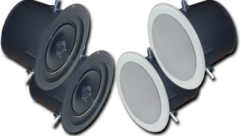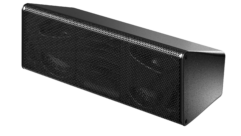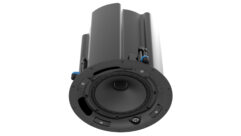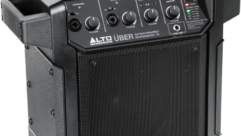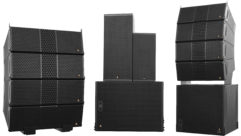Powered Molded Speakers
Oct 1, 2003 12:00 PM,
Allan Soifer
My initiation into the world of audio dates back to those dear old days of reentrant megaphone-type horns, back when we used acoustomechanically coupled drivers and three- and four-way joiners that were more like plumbing than sound reinforcement. Then I moved up into the big leagues — Altec-Lansing A2, A4, and A-7 systems, which were then the state-of-the-audio-art in portable speakers. (Portable meaning that they could be carried by two or three husky individuals with a forklift as backup.) These days audio operators and contractors are blessed by modern rotational molding technology, which can be used to produce everything from attaché cases to loudspeakers. I’ll take a look into the latter.
Rotational molding is simple in concept, if somewhat tricky in execution. The idea is to take a mold of the object to be formed, pour in a plastics compound (in powdered form), apply heat, and then spin the entire assembly around to distribute all the plastics equally into every nook and cranny of the master mold. This ensures proper forming of intricate corners and designs. Thus objects of almost any shape, size, and density can be created out of molded plastic. With rotational molding, parts can be formed economically, many of them impossible to produce by any other method, like loudspeaker enclosures with compartments for the powering electronics. (One roto-molding contractor offers a video slide show of the process. For those interested in the actual molding sequence itself, visit www.jacobsonplastics.com/RotoSplash.html.)
ROTO-MOLDED
Roto-molding allows features such as virtually stress-free parts, uniform wall thickness with no thinning in extremities, and the ability to create multipartitioned molded forms with inner walls, strengthening ribs, and so on. This concept is well refined, and it is producing a new crop of loudspeakers that are worthy of serious consideration by those who toil in the audio field. Manufacturers are offering bookshelf units, professional studio monitors, portable audio systems, and even major stadium and touring components in molded form. Injection molding is still popular, and that process produces high-quality enclosures, as well. In the injection process, the master mold is stationary, and the plastics compound is forced in under pressure to create the object. Some of the manufacturers listed in this article produce loudspeakers in one or both manufacturing styles.
Passive loudspeakers were the first to benefit from roto-molded enclosures. Many large and costly touring systems could not have been safely flown overhead or installed in a reasonable amount of time if the individual units had not been molded enclosures. Some of the newest powered systems effectively cover a large room of 1,000 seated people and are still sufficiently easy to transport; the speakers, tripod stands, and cables can all be packed into an average passenger car. Harnesses and flying hardware are easily incorporated into molded enclosures, either passive or powered. Some manufacturers offer models both ways, with and without flying and suspension tackle. In this showcase, I’ll be taking a look at the new crop of powered speakers in roto-molded enclosures. Because it’s not feasible to mention every single type or model that is sold, I’ll focus on the most popular and readily available units.
WHAT’S OUT THERE?
Long famous for its professional loudspeakers and audio equipment, JBL‘s second generation of its EON series, the G2 systems, feature the EON10 G2, the EON15 G2, and the EONSUB G2 powered subwoofer. The numbers in the name indicate the size of the woofer. Preliminary specs for the 15 are a frequency response of 42 Hz to 17 kHz ±3 dB and a maximum SPL of 129 dB. Both systems share many features, including a built-in 3-input minimixer. Also available are E-Systems that package a pair of speakers (either the EON10 or 15), a Soundcraft mixer, a couple of AKG mics, and all the cables you need to make it all work. The speakers feature interesting aesthetic shapes and are eye-catching on a speaker stand. The company’s entire line is worth a serious look.
Mackie, long respected for its low-noise, well-built, and reasonably priced audio consoles, offers the SRM450. Mackie claims that this unit is unusually precise and powerful as a music playback speaker. Mackie avoids calling this model a P.A. speaker, instead referring to it as an active-technology, high-end studio monitor. The SRM450 incorporates a 12-inch low-frequency driver, and the specified frequency response of the system is 55 Hz to 18 kHz (-3 dB). Maximum peak SPL is rated as 127 dB. Mackie’s Web site has announced that the SRM 350 is coming soon. Mackie also makes the ART series, featuring the 200A, 300A, and 500A active models.
Peavey is well known as a manufacturer of audio components and electronic support and processing equipment. The company offers the Impulse 100P, 1012P, and 1015P as its powered molded products. The 1012P and the 1015P claim 500W total power in a biamplified system and a peak SPL in excess of 130 dB. Both units use Peavey’s BWX Black Widow woofer (12-inch and 15-inch respectively), and the systems share the RX22 high-frequency compression driver. The Impulse 100P is biamplified as well with 200W of total power and a peak SPL in excess of 120 dB. The 100P comprises a 10-inch LF driver and the 14XT compression HF driver. Offered as an option for all molded products is Peavey’s Molded Cabinet Care Kit, which includes a spray bottle of cleaner and a polishing cloth.
Many of the molded speakers available are weather resistant, making them ideal for outdoor use. Crest Audio features the LQ line, comprising the LQ10P, LQ12P, and LQ15P, with water-resistant speaker cones. Designed for primary sound reinforcement, the LQ-12P is capable of reaching 130 dB SPL at 1 meter (earplugs and health insurance are not included). High frequencies are handled by a 2-inch titanium diaphragm compression driver coupled to a 1-inch quadratic throat horn that is molded to the cabinet — another one of the incidental benefits of the roto-molding process. The frequency response of the LQ-12P is 61 Hz to 18 kHz (±3 dB). The LQ-10 P comes in with 120 dB peak SPL with music and a frequency response of 80 Hz to 20 kHz, and the LQ-15P boasts a music peak SPL of 100 dB and a -10 dB low-frequency point of 45 Hz. Upper response is to 18 kHz. These units feature internal electronic two-way crossovers with CD horn EQ, level matching, active bass boost, and subsonic filtering. The crossover has the horn spatially aligned with the woofer, so there is no need for phase alignment or time delay of the signals. These design features make life easier for the installer as well as the operator.
Gemini Sound Products offers several powered units among its molded enclosures, including the two-way GX-350 with a 12-inch woofer and the GX-450 with a 15-inch woofer. Their specs are comparable to most of the midline units offered by other manufacturers and are priced for the consumer budget. Both systems also feature a built-in mixer, with one mic (XLR and ¼-inch TRS) input and one line (XLR and RCA) input.
Electro-Voice is another power name in the audio industry, and its molded enclosures have a rather interesting and innovative look. Electro-Voice offers a credible powered enclosure, the S×A100+, which boasts 350W LF and 80W HF (burst) amplifier power into a two-way system and a patented dynamic filter system to catch signal overloads. Stated max SPL is 124 dB. The company still crafts much of its loudspeaker line in plywood (including an optional powered subwoofer for the S×A100+), so you traditionalists out there need not despair.
Another traditional audio manufacturer is Yamaha, which has several powered molded systems, with the MS300 topping the line. Its features and specs are typical for this class of component, with the professional consumer market in mind. One outstanding feature is the owner’s manual. Yamaha goes to great lengths to produce a comprehensive set of diagrams and mounting instructions, along with the usual specs and dimensions. Typical of all Yamaha product instructions, the MS300 manual features several installation suggestions. Professional users may remember Yamaha’s first venture into large audio consoles in the ’70s, the PM series. The manuals for those models were almost a complete course in electronic audio processing and installation. I still have mine, and it offers good reading. Yamaha also manufactures one of the smaller products in this showcase, the MSR100. The MSR100 comprises an 8-inch woofer and a 1-inch titanium compression high-frequency driver. Rated maximum SPL is 112 dB with a frequency response of 55 Hz to 20 kHz (-10 dB). This compact system also features a 3-input mixer with a master EQ.
Innovative packaging gains inclusion in this showcase for the Passport 150 and 250 from Fender, the musical instrument giant. Although the amplifier is not built in to the enclosure, the portable system includes a powered mixer that packs up neatly sandwiched between the two speakers. Power outputs and features range from medium auditorium size down to small hand-carried reinforcement with a built-in wireless mic. The smaller P10 and P10W models feature internal amplification. They should not be overlooked as a dependable alternative.
Bose is strangely absent from the powered molded speakers market. Oddly enough, the original innovator of portable molded speakers (the 800 series is known and raved over around the world for lightweight and wide range dispersion) does not offer a powered model. One can only hope that Bose will surprise systems integrators soon.
Anchor Audio is well known in the A/V supply and rental industries. Molded powered enclosures have been Anchor Audio’s stock in trade for more than 15 years. With an extensive range of products, Anchor markets interesting loudspeaker systems complete with CD players, tape players, and wireless mics integrated into the enclosure. The manufacturer claims that its model XTR-6000 Xtreme system will provide decent speech and music playback coverage to a crowd of more than 4,000 in an indoor venue. On the small end of the scale, Anchor offers the diminutive AN-100 and AN-1000X. The AN-1000X features a 4½-inch woofer and a dome tweeter and can run on battery or AC power. It has balanced and unbalanced inputs and a maximum SPL of 103 dB. Anchor also offers several other models that either have that ability to run off of AC and battery as well as units that are exclusively battery powered. If you are supplying or renting to educational or hotel clientele, it’s worth looking into.
POWER UP
Molded speaker enclosures are rapidly taking their place among the other types of high-quality reproduction systems. With some innovative amplifier designs and servo circuits, the powered variety is starting to change the industry’s thinking about separate amps, speakers, and ancillary hardware. The same technology that provides you with near bulletproof attaché cases and toolkits is becoming an everyday adjunct to the audio reinforcement industry. Make good use of it.
Allan Soiferlurks and works in eastern Ontario, Canada. E-mail him at[email protected].
Why Powered Molded Units?
If you’ve never done audio using powered portable speakers, it’s a treat to see how quickly and easily audio reinforcement can be implemented. Fig. 1 shows a basic system for music, but the concept is adjustable to anything from speech only to high-quality amplification for large-screen video viewing. Using powered speakers simplifies the install and teardown, eliminates excessive cable runs, and reduces the need for specially trained operators. Anyone with a basic understanding of electronics can successfully do the job, which means that clients who insist on lowballing your estimates can be offered the opportunity of doing it themselves.
The loudspeakers shown in Fig. 1 could be larger enclosures at the stage periphery or could just as easily be on stands at front and sides of the house. Many models can also be used as floor monitors by virtue of angled cabinets or accessory mounting items. Those are the major benefits of powered molded units — lighter handling weight, versatility, and ease of use. Check out the Internet Sound Institute (www.soundinstitute.com) for more helpful information.
For More Information
Anchor Audio
www.anchoraudio.com
Ž 201
Crest Audio
www.crestaudio.com
Ž 202
Electro-Voice
www.electrovoice.com
Ž 203
Fender
www.fender.com
Ž 204
Gemini Sound Products
www.geminidj.com
Ž 205
JBL Professional
www.jblpro.com
Ž 206
Mackie
www.mackie.com
Ž 207
Peavey
www.peavey.com
Ž 208
Yamaha
www.yamaha.com
Ž 209
Ž Circle this number on Reader Service Card or visit freeproductinfo.net/svc


